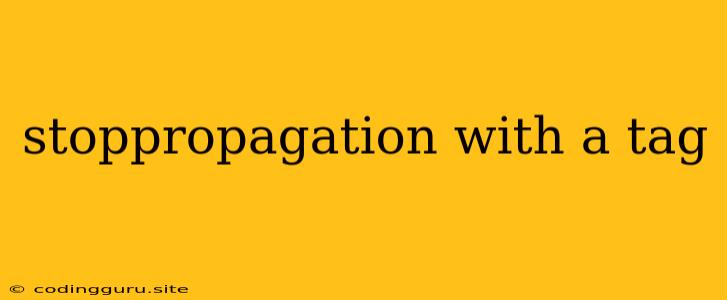Understanding and Implementing StopPropagation with a Tag in JavaScript
Event propagation in JavaScript is a fundamental concept that describes how events flow through the DOM (Document Object Model) tree. When an event occurs on an element, it triggers a chain of events, bubbling up from the target element to its parent, and eventually reaching the document root. This behavior can sometimes lead to unintended consequences, as events might trigger multiple event handlers, resulting in unexpected actions. This is where the stopPropagation() method comes into play.
What is StopPropagation?
stopPropagation() is a powerful method in JavaScript that allows you to stop the event from bubbling up the DOM tree. It effectively prevents the event from reaching any parent elements, ensuring that only the event handler on the current element is executed.
Why Use StopPropagation with a Tag?
The stopPropagation() method is particularly useful when dealing with nested elements, especially when you want to prevent an event handler from being triggered on parent elements. Imagine a scenario where you have a button inside a <div> element. When the button is clicked, you might want to perform a specific action within the button itself, without triggering any event handlers on the containing <div>.
Here's a simplified example:
const button = document.getElementById('myButton');
const container = document.getElementById('container');
button.addEventListener('click', (event) => {
console.log('Button clicked!');
event.stopPropagation(); // Stop propagation
});
container.addEventListener('click', () => {
console.log('Container clicked!');
});
In this example, clicking the button will print "Button clicked!" to the console, but it will not print "Container clicked!". This is because stopPropagation() is called on the button's event handler, preventing the click event from bubbling up to the container element.
Common Use Cases for StopPropagation with Tags:
- Preventing Unwanted Actions: When you have nested elements and you only want a specific action to be performed on a particular element,
stopPropagation()can help prevent unintended consequences. - Creating Clickable Areas: You can use
stopPropagation()to create clickable areas within a larger element without triggering events on the parent element. - Customizing Navigation: When handling navigation events, you can use
stopPropagation()to control how the navigation event propagates through the DOM, allowing you to create custom navigation behavior.
Implementation Tips:
- Call
stopPropagation()in the Event Handler: Ensure you callstopPropagation()within the event handler of the element where you want to stop propagation. - Use It Sparingly: While
stopPropagation()is a useful tool, it should be used judiciously. Overusing it can hinder the natural flow of events in your application, potentially leading to unexpected behavior. - Consider Alternatives: Before resorting to
stopPropagation(), consider other methods likeevent.preventDefault()orevent.stopImmediatePropagation()to address your specific needs.
Conclusion:
stopPropagation() with a tag is a powerful technique for controlling event propagation in JavaScript. By preventing events from bubbling up the DOM tree, you can ensure that only the intended event handlers are triggered, leading to cleaner and more predictable behavior in your web applications. Remember to use this method thoughtfully and consider its impact on the overall flow of events in your application.
